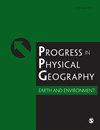Comprehensive assessment of rock glaciers in the Himachal Himalayas: Updated inventory and labelling
IF 3.6
3区 地球科学
Q2 GEOGRAPHY, PHYSICAL
Progress in Physical Geography-Earth and Environment
Pub Date : 2024-07-21
DOI:10.1177/03091333241263986
引用次数: 0
Abstract
Rock glaciers are geomorphological features often used as a visible expression of mountain permafrost. These are creeping ice-debris with distinct ridge and furrow structures on the surface with a steep frontal slope. Rock glaciers, being the valuable past permafrost indicators, also have utmost hydrological significance in near future. Therefore, mapping of rock glaciers is an important step in order to understand permafrost regimes better. The Himalayas have large occurrences of these features and this study in Himachal Himalayas complied 789 rock glaciers, covering an area of about 336.2 km全面评估喜马偕尔喜马拉雅山脉的岩石冰川:最新清单和标签
岩石冰川是一种地貌特征,通常被用作山区永久冻土的明显表现形式。这些冰川是匍匐的冰屑,表面有明显的山脊和犁沟结构,前坡陡峭。岩石冰川是过去宝贵的永久冻土指标,在不久的将来也具有极其重要的水文意义。因此,绘制岩石冰川图是更好地了解永久冻土机制的重要一步。喜马拉雅山脉有大量的岩石冰川,本研究在喜马偕尔喜马拉雅山脉绘制了 789 个岩石冰川,覆盖面积约 336.2 平方公里。根据成因、位置、形状、形态、地表起伏和活动的不同标签,我们发现岩石冰川主要来自滑石斜坡(239 条),呈舌状(377 条),主要分布在山圈(531 条)。大多数冰川被归类为简单单元(603 个),具有发达的地表起伏(387 个),而且主要保存完好(760 个)。地形参数表明,大部分岩石冰川位于海拔 4000 至 4800 米之间,平均海拔为 4635 米。这些岩石冰川位于坡度从缓到陡的斜坡上(0 至 45°),弯曲度在-3.5 至 4.5 之间,大部分呈凸形弯曲。喜马偕尔邦有利于岩石冰川形成的坡向为北向(N、NW、NE)。这些岩石冰川的主要地质属于板岩、辉绿岩、石英岩、石灰岩和玄武岩。气候参数和指数对岩石冰川的出现也有很大影响。大多数岩石冰川的平均地表温度(LST)在 0 至 -15°C 之间。所有岩石冰川的平均 NDSI 介于 0.04 到 0.68 之间,平均 NDVI 介于-0.06 到 0.08 之间。总体而言,该清单和标签是了解喜马拉雅山岩冰分布和特征的宝贵数据库。
本文章由计算机程序翻译,如有差异,请以英文原文为准。
求助全文
约1分钟内获得全文
求助全文
来源期刊
CiteScore
7.20
自引率
5.10%
发文量
53
审稿时长
>12 weeks
期刊介绍:
Progress in Physical Geography is a peer-reviewed, international journal, encompassing an interdisciplinary approach incorporating the latest developments and debates within Physical Geography and interrelated fields across the Earth, Biological and Ecological System Sciences.

 求助内容:
求助内容: 应助结果提醒方式:
应助结果提醒方式:


